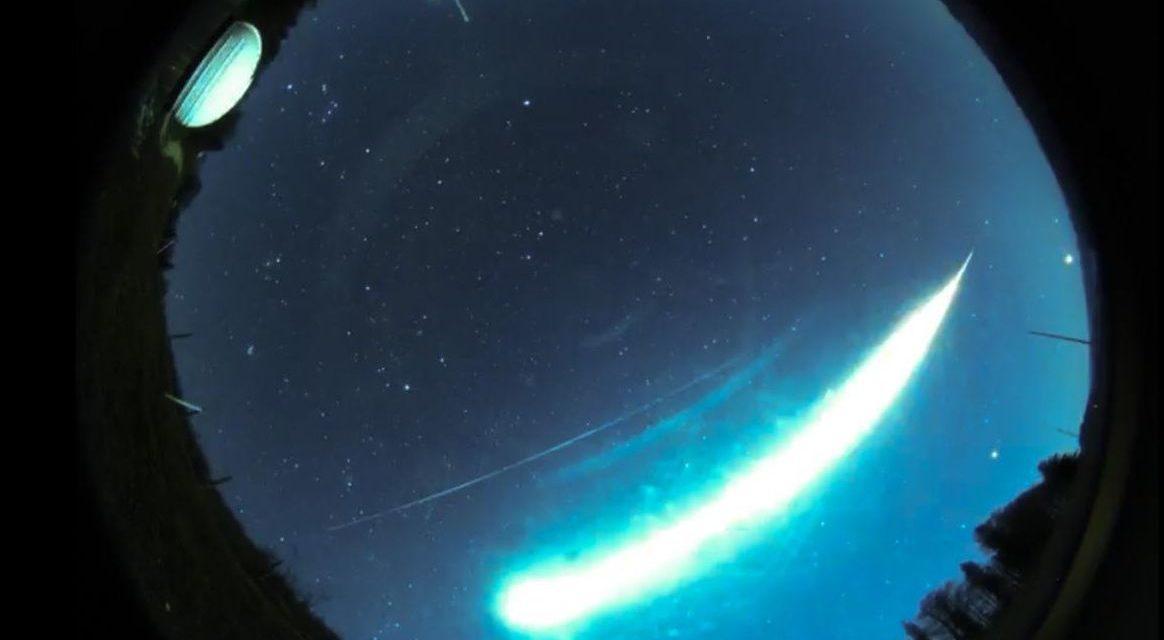On 19 November, 2020 at 3h46m55s UT a bright meteor lights up the sky above Austria. Despite the early hour there were many visual observations about the long, low angle flight and the rumbling noise after some seconds. As always, meteorological cameras and dedicated meteor cameras caught the phenomenon across and around the country, addition to that some professional and amateur photographs had taken with great fortune. Based on the characteristics of the fall and the calculated values, there is a high probability that meteorites reached the ground.


Two all-sky pictures’ author: Rudi Dobesberger – Sternfreunde Steyr
Initial data
Firstly I’ve seen a picture about the fireball from an Austrian amateur astronomer who was able to photograph the bolide on clear sky with fine resolution. This has been published on Facebook, from there I could download many others’ videos, among them the great montage of AllSky7 Fireball Network Germany. Of course some Czech meteorological camera around the area recorded the event too. The sky was totally cloudy above Slovakia and Hungary so no observations from there. I had to manually calibrate all of the pictures from different cameras with UFOAnalyser (Sonotaco, 2009).
Trajectory
I wrote a program – called Metlab – to help organize, transform, store and export all data to R91 format, which is readable to UFOOrbit (Sonotaco, 2009). Depending on how accurate the calibrated images are, I excluded some of them from the final solution. On the end I kept four different records.
- AllSky7 Fireball Network – Seysdorf, Germany
- AllSky7 Fireball Network – Salzburg, Austria
- Hermann Koberger’s image from Fornach, Austria
- 2 images of the meteorological camera of Znojmo, Czech Republic
In all the cases, the maximum calibration error was around or below 0.1 degree, which is acceptable.


The meteor started its luminous path at 89±0.9 km reaching the atmosphere with 15.6±0.1 degrees inclination. It flew with an average speed of 13 km/s from Furt im Wald (Germany; N49.2716, E12.9172) to Weichselboden (Austria; N47.7026, E15.1591) during more than 23 seconds. The fireball flew more than 240 km trough the atmosphere and formed a 16 km long cloud of debris at the end of its path. The meteor’s fragments decelerated a lot in this phase until less than 2.2 km/s. I could calculate the deceleration by doing frame by frame measurement of the Salzburg’s and Seysdorf’s video for different heights during the fall. They also contained information about the initial velocity which was greater than 14.3 km/s. The last fragments of the body could penetrate 24.7±0.5 km deep into the Earth’s atmosphere. The calculated end of the trajectory was 27.2 km because a program like UFOOrbit try to approximate the path as a straight line, but with this shallow angle and low speed the gravitational deflection was a whopping 2.5 km !

Dark flight
- The visual observers heard a thunder-like sound after the event.
- The fireball penetrated deeply into the atmosphere.
- The measured velocity slowed down below ablation speed.
All of these suggest that some remaining debris could reach the ground. I used Metlab – self-developed program – to calculate the strewn field with the initial data above. Unfortunately, I couldn’t find any high atmospheric wind measurement about that date, maybe because of the pandemic. The nearest data came from Munich, I had to use that. Wind and atmospheric data can be retrieved from the University of Wyoming (Department of Atmospheric Science) website. Taking into consideration the luminosity of the fall, the strewn field picture contains meteorite size from 100 g. to 1 kg. Bluish colors mean that the pieces started their dark flight phase from higher, while whites started lower altitude.

Orbit
As seen from the speed diagram, the deceleration was great along the whole trajectory, so I used only the first three seconds of the flight – where the meteoroid kept its entry velocity quite the same speed – to calculate the orbit of the fireball with the help of UFOOrbit. It’s originated from an Apollo type orbit – from the main asteroid belt between Mars and Jupiter – with a very small angle to the plane of the solar system.


The resulting orbital elements are:
- α = 357.8°
- δ = +22.6°
- a = 2 A.U.
- q = 0.955 A.U.
- e = 0.533
- ω = 205.5°
- Ω = 237°
- i = 5°
References
- SonotaCo (2009). “A meteor shower catalog based on video observations in 2007-2008”. WGN, Journal of the International Meteor Organization, 37, 55–62.
- University of Wyoming – http://weather.uwyo.edu/upperair/sounding.html
- AllSky7 Fireball Network Germany – https://allsky7.net







